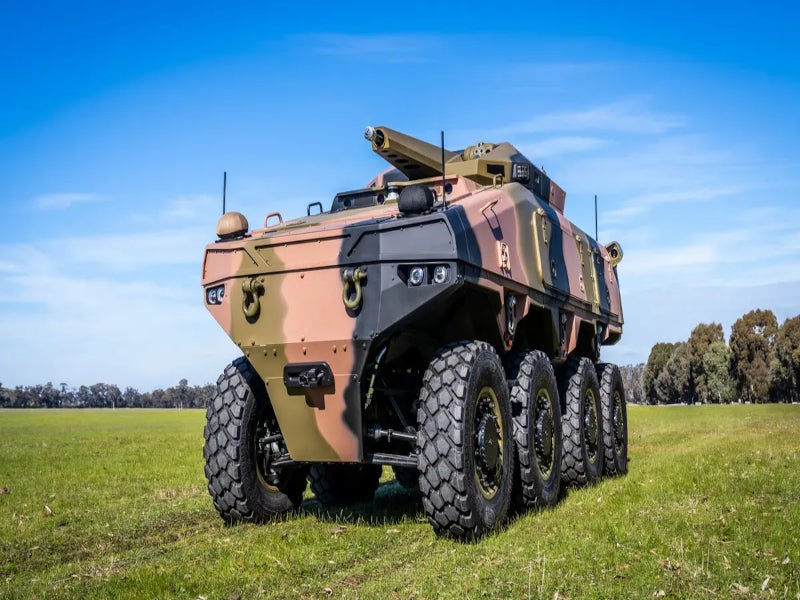The Autonomous Tactical Light Armour System (ATLAS) Collaborative Combat Variant (CCV) is a new uncrewed ground vehicle (UGV) developed by BAE Systems, an aerospace company.
It can undertake reconnaissance and surveillance, combat wingman, and assault missions.
The vehicle is designed to provide soldiers with a significant edge in contemporary combat scenarios, offering an autonomous platform tailored to execute the monotonous, hazardous, and arduous tasks prevalent in warfare.
Launched in September 2024, the ATLAS CCV is engineered to function autonomously both on-road and in rugged terrain, thereby augmenting the capabilities of crewed vehicles such as infantry fighting vehicles and main battle tanks.
ATLAS CCV vehicle design and features
The ATLAS CCV is an eight-wheel (8×8) modular drive vehicle weighing 10t. It can be upgraded over time to adapt to evolving technologies and threats.
The vehicle uses the company’s established autonomous uncrewed systems architecture, which has been instrumental in powering various uncrewed aircraft, vehicle systems, and autonomous missile defence technologies.
Designed for easy transport, the vehicle fits into a standard 20ft ISO container or flat rack and serves to enhance the logistical capabilities of existing crewed platforms by extending their operational endurance.
It features a sophisticated suspension system and a stable base for precise firepower. The ATLAS CCV features a Supacat driveline with a high degree of commonality with the HMT vehicle family. It is equipped with vehicle management, mission management, and payload management systems.
The vehicle offers all-axle and crab-walk steering capability, with a minimal turning radius of under 13m. The vehicle’s agility is further demonstrated by its ability to traverse a 2m gap, scale a 1m vertical step, and negotiate gradients of 60° and side slopes of 30°. It also features a central tyre inflation system and run-flat inserts for enhanced mobility and survivability.
Details of ATLAS CCV’s command and control system
The vehicle’s command and control (C2) system uses low-probability-of-intercept communications, enabling effective crewed-uncrewed teaming. It ensures human oversight for both vehicle and turret operations, as well as involvement in weapon engagement.
The ATLAS CCV is designed with ample stowage capacity, accommodating several tonnes of residual payload within its protected hull. This allows it to transport essential resupply items for crewed platforms, including ammunition, fuel, rations, water, and mission-critical equipment.
It is equipped with an advanced sensor suite that integrates with its autonomous system, providing the vehicle with both self-awareness and situational awareness. Equipped with 360° multi-spectral target detection, tracking, and classification, it leverages a range of technologies, including day cameras, thermal imaging, acoustic sensors, passive electronic warfare, stereo vision, and light detection and ranging (LiDAR).
Weapons system of ATLAS CCV
The ATLAS CCV is armed with a stabilised 25mm M242 Bushmaster cannon integrated with the VANTAGE automated turret system (ATS™), a medium-calibre turret system capable of engaging targets up to 2,500m away.
The turret, designed for a low profile to reduce vehicle exposure, features a ‘human-in-the-loop’ targeting capability and can achieve an elevation of more than 70°. It also offers the flexibility for the adaptive reuse of existing cannon stocks.
The 25mm gun features a dual ammunition feed system and a ready-use ammunition capacity of 260 rounds. The vehicle can also provide indirect fire support through a 120mm automated mortar system.
Propulsion of ATLAS CCV
The ATLAS CCV powerpack shares commonality with the Supacat HMT range of tactical vehicles. It is driven by a Cummins ISB 6-cylinder 6.7-litre diesel engine, coupled with an Allison 3000 automatic transmission.
The Allison 3000 Series is designed to enhance fuel efficiency and simplify operation in medium-duty vehicles.
Operational capabilities of ATLAS CCV
The ATLAS CCV offers multiple autonomous operating modes, including teleoperation, ‘follow me’ with obstacle avoidance, waypoint navigation with obstacle avoidance, and goal-based mission planning.
The vehicle can execute dynamic uncrewed vehicle functions such as autonomously receiving real-time user control while following a specified geometric path and generating paths to evade obstacles and navigate challenging terrains, such as dense forests.
It can move forward for reconnaissance and surveillance or remain in place as a ‘sentry’ to detect and track threats, relaying information to other combat units.
In reconnaissance and surveillance mode, ATLAS can also perform overwatch and electronic surveillance tasks. It can also be adapted for counter-uncrewed aerial vehicle (C-UAV) operations.
Contractors involved
BAE developed the ATLAS CCV in partnership with Supacat, a military vehicles manufacturer, to supply the chassis platform; Valhalla Turrets, a weapon systems solutions provider, for turrets; and Marand, a precision-engineered solutions provider, to manufacture the vehicle hull.




